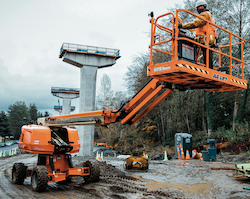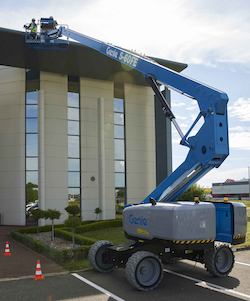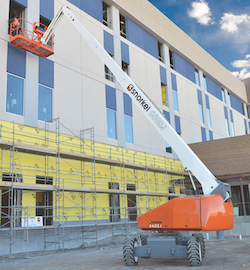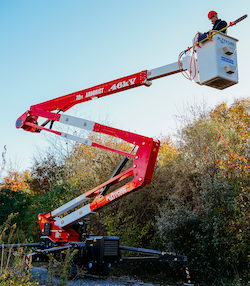Equipment Insight – Boom Lifts
Today’s models offer a better hand-in-glove fit on job sites, improving safety and productivity.
 |
|
SIMONE MACIE |
Demand for indoor/outdoot, no-emission equipment increases
There is an increasing demand on large job sites for clean, quiet and versatile equipment that can work indoors and outdoors, including on rough terrain. Genie has been working to meet this need by expanding its range of electrified products, including boom lifts.
 |
|
In the past, boom lifts were primarily designed to develop best-in-class specifications. Today, that’s all changing. Now, machine designs give more attention to the demands of real-world job sites — and the needs of the users operating these machines.
|
 |
|
High-efficiency, maintenance-free AC drive motors on all four wheels provide similar torque as hydraulic-drive motors and better rough terrain performance while using up to 40 percent less energy and reducing total cost of ownership. |
 |
|
Snorkel has expanded its drive/steer modes. Select models feature additional modes that dramatically increase maneuverability and allow larger machines to be operated safely in challenging environments. |
 |
|
Lifts that have multi-functional abilities will allow rental centers to book a wider variety of jobs. For example, Tracked Lift models provide air/water and electricity hook-ups in the basket so they can be booked for tree work; power washing; window cleaning or light bulb changing; painting; hanging holiday lights in spaces ladders cannot reach; museums; and network component and cable installation. |
 |
| Haulotte paired the 24-horsepower engine with a four-wheel drive mechanical axle. This combination meets customer requirements for on-the-job performance and saves money by using less fuel. |
The most recent additions to that lineup are the electric Genie S-60 DC and hybrid S-60 FE telescopic boom lifts, which meet the industry’s demand for a machine that can operate in rough terrain while reducing job site emissions.
High-efficiency, maintenance-free AC drive motors on all four wheels provide similar torque as hydraulic drive motors and better rough-terrain performance while using up to 40 percent less energy and reducing total cost of ownership. Four-wheel drive plus electronic traction management and active oscillating axles enable 4 mph drive speed and 45 percent gradeability in rough terrain.
Another relatively recent advance for boom lifts, in general, is the use of sophisticated sensors to make sure operators stay within the allowable range of motion. Genie’s digital load-sensing continuously monitors, in real time, the load in the platform, while other sensors monitor the envelope.
For rental centers considering fleet updates, a major consideration is likely how the rental center can get the most ROI from the investment they are making. This means looking at the total cost of ownership in addition to the initial acquisition price. Acquisition price, while important, is just one part of the total cost calculation. Things like maintenance costs, reliability, which affects uptime, and residual value impact how much value the rental center will get out of the equipment they purchase for the time they own it.
Fleet mix is an important consideration as well. This is why Genie offers J booms for everyday jobs, hybrid FE and DC electric booms that offer reduced noise and emissions, and heavy-lifting Xtra Capacity (XC) booms to help rental companies match the right machine to their customer’s application.
For example, the S-60 J and S-80 J telescopic booms are productive, performance-oriented booms that are well-suited for most everyday work-at-height jobs. With a platform capacity of 660 pounds and a 6-foot jib, they are the right match for a wide range of tasks such as general construction, maintenance and painting. In addition to offering the job site performance contractors need, they feature a simple design that reduces maintenance needs and wearable and replaceable parts, which lowers the total cost of ownership.
On jobs that require heavier lifting capabilities, consider Genie XC boom lifts. Their higher capacity means you can take more material and tools to height at one time, which means fewer lift cycles. This saves time and, therefore, money. Examples include shipyards and glaziers where Genie’s tallest XC booms can handle up to 1,000 pounds of material and workers.
Electric DC booms are becoming increasingly popular options for job sites looking for a productive, low-noise machine without emissions. Where indoor/outdoor versatility is needed, the hybrid FE boom is the right match because it can be used in hybrid mode during early build stages – when charging infrastructure may not be available – and later for indoor work in all-electric mode. The ability to keep the same unit on-site, vs. replacing the unit with another, is more cost-effective for the rental company and more convenient for the customer.
Rental centers looking to increase their ROI should start by thinking about their fleet wholistically, making sure it includes machines that can be matched to specific job site needs, have good versatility, and a low total cost of ownership.
 |
|
Nate Hoover |
New machines better match job site needs
In the past, boom lifts were primarily designed to develop best-in-class specifications. Today, that’s all changing. Now, machine designs give more attention to the demands of real-world job sites and the needs of the users operating these machines.
For example, the new JLG 670SJ self-leveling boom lift is a machine has a unique feature. Its smart chassis technology allows the machine to automatically level on grades up to 10 degrees when in self-leveling mode. This self-leveling technology enables the boom to do something no other boom can do; its development is a story of customer-inspired innovation.
JLG developed this capability because of our teams watching how boom lifts work on job sites, as well as talking with operators who use this type of equipment every day. There are many applications and working environments that can be rather challenging for a traditional oscillating axle boom lifts to work in. These machines are rated to work on firm, level surfaces with 5 degrees or less of grade, and most job sites aren’t flat and not every job site has an improved surface.
These situations make operators put in extra effort to get work done at height. In many cases, workers come up with creative ways to make their boom lifts productive on real-world job sites, such as:
- Constant repositioning
- Removing small areas of earth with a compact loader to level the ground
- Employing a longer boom lift to reach the work area from a level spot beyond where they would ideally like to place the machine
- Using multiple boom lifts
- Cribbing the machine on a localized platform to attain a level work surface
- Shoring up the ground or using stone to make a raceway to attain a level work surface
Most of these options come with hidden costs, often requiring excessive labor, long-term fixed space utilization, specialized experience and/or larger footprint requirements. They also often result in the low-value utilization of a high-expense asset.
Self-leveling technology adjusts the boom lift’s chassis to the ground conditions rather than trying to adjust the ground conditions for the machine. It is a fully integrated solution that makes sure the machine automatically levels, even when driving the unit elevated.
As operators tested the self-leveling boom lifts, they shared some of the advantages this technology offered them:
- Fewer chances for dropped tools
- Operators and occupants were more stable during travel due to reduced bouncing of the unit as it traversed uneven terrain for improved operation and reduced fatigue
- Safety features with improved productivity, which translated to more work getting done
- Reduced platform occupants’ fear of heights due to a smoother ride
- Offered greater stability; operators reported feeling more secure while driving
As the adoption of new technologies in boom lifts gains momentum, rental centers should understand how these machines adhere to the current industry standards, as well as improve operations’ efficiency and safety.
With changes such as load and tilt sensing that require operators to do more advanced planning of work at height, rental centers need to make sure that it’s possible for their customers to complete the work with compliant equipment.
When contemplating adding these modern machines vs. more traditional models, rental centers need to carefully consider how the application impacts which boom lift is right for the job. With newer machines, such as the JLG 660J boom lift with self-leveling technology built-in, their customers will be more easily able to complete the work without extra planning.
In concept, new technology like what is incorporated into JLG’s self-leveling boom lift sounds great but the first thing rental centers and their customers, need to know is how it works when put to the test in real-world work
applications.
The best way for rental centers to increase demand for and/or increase ROI with these units is to show customers through equipment demonstrations what this new self-leveling chassis technology is all about.
If a rental center doesn’t have one of these new boom lifts available, they can check out this video series highlighting real JLG customers sharing how this new solution solved their common job site challenges.
Go to https://procontractorrentals.com/pages/News-12_2_22-JLG-7-part-series-in-self-leveling-boom-lifts.php to view the videos.
 |
|
Jake Adkins |
Telematics to the rescue
One of the recent advances on boom lifts that has been a huge benefit to Snorkel’s customers is telematics, which allows for more efficient fleet management and provides real-time feedback on the location and status of machines in the user’s fleet. It also allows remote management of software and diagnostics, giving customers a complete picture of the health of their machines.
Another recent development for Snorkel is expanded drive/steer modes. Select models feature additional modes that dramatically increase maneuverability and allow larger machines to be operated safely in challenging environments.
Also available on some Snorkel boom lifts is the electric traction drive on battery-powered models. This feature increases reliability, decreases service intervals and allows for much more efficient use of power.
Snorkel has also engineered user-friendly control systems with advanced operator interfaces on select Snorkel models. These systems keep the operator informed of the machine’s status in simple, easy-to-understand prompts. This makes the machine simpler to use and makes it easier to train new operators.
When selecting boom lifts to be used in the rental market, it’s important to consider reliability, total cost of ownership, ease of use and maintenance, connectivity, the manufacturer’s service network and the machine’s overall efficiency.
To increase demand, rental centers should demonstrate new features and advances to customers in a way that illustrates the value to their operation. Show potential renters how the optimized ease of use and/or communication will result in less service involvement with the machine, and therefore an overall increase in efficiency.
 |
|
Tom Schneider |
Hybrid power adds versatility
Tracked Lifts is deploying the capability to remotely diagnose some lift models when they need service or experience malfunction. This answers customers’ needs, as it shortens the troubleshooting cycle and saves money by allowing us to intelligently stock spare parts and route field service technicians.
When considering bringing new lifts into a rental fleet, it is important to consider a variety of things. The first thing to consider is lifts that have automation technology such as automatic leveling and automatic stowing.
Versatility in the jobs a lift can accomplish is also something to consider. For instance, lifts that run on a hybrid power source will allow greater flexibility in job bookings, as they can be deployed indoors on electric power and outdoors on gasoline/diesel power.
Lifts that can fit into tight spaces can also provide more value than a larger machine. Many Tracked Lifts models have a small footprint and can fit through a standard 36-inch door without sacrificing maximum working height.
Lifts that have multi-functional abilities will allow rental centers to book a wider variety of jobs with one lift. For example, Tracked Lift models provide air/water and electricity hook-ups in the basket. These models could be booked for tree work; power washing; facilities needing window cleaning or lightbulb changing; painting; hanging holiday lights in spaces where ladders cannot reach; museums that need to dust large exhibits with compressed air; and network component and cable installation. When you include these features in a rental lift, the list of job applications becomes endless, and thus will have the unit booked more often.
The lift features mentioned above are all important things to consider when selecting lift models for a rental fleet. By owning an extremely versatile and easy-to-use lift, rental centers can increase sales opportunities in their current supplied markets, thus increasing ROI. Rental centers can expand the breadth of their promotion into markets they may not have touched in the past. Some of the sectors worth marketing toward include arborists, facilities, cable companies, landscapers, retail spaces and painters.
 |
| Paul Jensen Product Manager Haulotte Group |
Smaller engine strategy
The Haulotte HT46 RTJ telescopic rough-terrain boom lift is Haulotte’s first boom following a new strategy of using a smaller internal combustion engine power source combined with a mechanical axle drive train. Shrinking the size of the engine significantly reduces emissions and noise and has made these engines easier to work on because they are less complex. The smaller engine makes it easier to access all components under the hood.
A smaller engine on its own would not have enough power to drive a standard, hydraulic machine across rough terrain on construction sites. To address this, Haulotte paired the 24-horsepower engine with a four-wheel drive mechanical axle. This combination meets customer requirements for on-the-job performance and saves money by using less fuel. This engine is still powerful enough to run a 9 kW generator so operators can run tools or weld from the platform.
Haulotte rough-terrain boom lifts feature the Activ’Screen, giving operators and technicians insight into the health of the machine. When there is an error, it provides a plain-text explanation of the trouble code, a picture showing the location of the part that needs repair and instructions on how to further diagnose or repair the problem. Haulotte machines with Activ’Screen keep rental center technicians happy because diagnosis and repair is simple and straightforward.
Safety managers like the Activ’Shield Bar that prevents operator crushing injuries. Operators like that the Activ’Shield Bar is integrated into the control panel system while providing an unobstructed view of the joysticks and controls, making smooth and precise boom movements simple. Rental centers like the Activ’Shield Bar’s rugged control box cover that prevents damage to the platform controls from weather, or debris.
Delivery drivers like the Activ’Lighting System that automatically turns on LED lights in low light to illuminate the ground and operating panels which makes loading/unloading machines in the dark safe and easy.
In addition to the features that have been incorporated into the machines, Haulotte has reduced total cost of ownership (TCO) by design. Modular platforms allow for quick repairs if a customer damages one of the floor panels, guardrails or control panel components. All hydraulic hoses are routed separately from electrical harnesses to prevent short circuits from leaks or chafing. Engines are mounted on pivoting tables, allowing technicians easy access to components and fasteners are treated to prevent corrosion even in harsh, salty conditions.
Haulotte design standards are appreciated by operators as well. Platforms with seven safety harness attachment points allow for easy movement around the platform. The Stop Emissions system shuts down the engine after 90 seconds of inactivity, reducing noise, vibration and fatigue for operators working in the platform.
-30-
This article originally appeared in the January-February 2023 issue of Pro Contractor Rentals magazine. ©2023 Urbain Communications LLC. All rights reserved.








